Outdoor Theater
My Outdoor Movie Theater.
We have used it several times now and it is a huge hit with all the neighbors.
2 of 12: As background information I will start with the audio portion of the setup. About 5 years ago after purchasing my indoor home theater setup I realized that I had purchased a multi-zoned receiver so I did the next logical step and wired my patio and balcony for audio and installed speakers outside for music. We spend a lot of time outside and I wanted something that would sound good, be easy to use and allow the source for audio to be selected while outside from any device connected to the receiver. This includes the DVD player, Radio/Tuner, Satellite TV and Audiotron (a networked mp3 player that streams music from PC/Server) as I have about 160 gigs of mp3s. I ended up going with a Niles Audio Intellipad that functions basically as a wall mounted remote control. It controls zone 2 of the receiver which also allows me to listen to a different source outside than inside. Here is a picture of it installed outside. I actually have 2 of these installed one for the patio/deck and the other for the balcony. It allows volume control, source selection, pause, stop, rewind, fast forward, skip, channel change, etc. for all programmed devices.
3 of 12: When I ran the wires for this I also pulled video and cat 5 wires just incase I ever wanted to add a TV outdoors. I never really thought that I would use them. I did all the wiring myself so it was not much more work pulling them and was a minimal cost for the wire. We have used the audio setup for years and been very pleased with it so now I fast forward to the video setup. I began working for a new company where I do presentations as a function of my job. The new company offered me a projector and I explained that I really did not need it as the customers will provide the projector for me to use. They insisted that I take it so I did. I have actually used it for work a couple of times as it turns out but when not in use it just sat in the closet. One day my wife and I were talking about our plans for an outdoor kitchen and she said what about a TV for outside. Then the idea hit me. I have a projector in the house and rather than just use a TV outside why not go bigger and setup an outdoor theater. That put the ball in motion. I began doing some research and found www.projectorcentral.com for the specs on my projector and as it turns out it appears to be quite decent. It is a business class Infocus LP530 projector with 2000 lumens. The contrast ratio could be a little better but what could I expect for free use of it. I also calculated that I could have a throw distance of about 21 feet on to a roughly 6’ 6” * 11’ 6” screen for the widescreen format. I began planning out how to build a screen using PVC then came across speaker stands. I liked the look of them and the flexibility of using speaker stands as a frame because it would allow me to easily adjust the height on both sides for my slightly sloping backyard and would allow me to easily move it if needed to adjust the throw distance. I began searching for speaker stands and then found what I thought to be the ultimate frame for my needs, a DJ light truss system. I selected one from MBT lighting as it allows for a height of 12’ with a width of 12’ and since it is a truss I figured there would be no sagging in the middle of the screen. Most that I found were only 10 wide. The cheapest place I could find it online was http://www.discountdjmall.com/index.asp?PageAction=VIEWPROD&ProdID=666 for 186.25. I thought the price was good and that I would spend close to that much on PVC, connectors and glue. Here is a picture of it assembled in the backyard with no screen.
4 of 12: Once I got the frame I knew I would need a bar across the bottom to support the bottom of the screen. I ended up buying 3 5’ sections of gold 1.5” aluminum tubing from eBay and cut them down to fit in the 12’ opening of the frame. I used 2 1.5” electrical conduit couplers to connect them together and spray painted the entire assembly black as shown in the picture above. The cost of the tubing with shipping was 40.00 and the couplers were about 2.50 each from a local electrical supply house. Next I needed some way to connect the bottom bar to the frame. I wanted some type of clamp that would allow me to adjust the position of the bar on the frame if needed. I ended up finding these clamps that worked perfectly. I attached the clamps using wing nuts so I could adjust them to fit the screen size. I purchased them from http://www.freudenthalmfg.com/clamps/clamp_03.html I got the model #2025 2” Tee Clamp. They were 15.75 shipped. They do not allow you to order online but do have an 800 number for ordering them.
5 of 12: Once the frame was in place it was time to move on to the screen. After reading a lot about black out cloth I decided to go that route since it was not terribly expensive. I did not want a seam in it so I ended up buying a single piece of 9’ * 12’ of BOC from http://www.carlofet.com/screens.html for 59.99 shipped. When I got the cloth I wanted to have it cut down to size, the edges doubled over for added strength and have 1.5” black webbing sewn around the edges. I took it to a local marine canvas shop that I have worked with in the past and had the guy cut and sew it for me. He got it done quickly and charged me 80.00 for the webbing and sewing. I thought that was a good price considering it would have taken me forever to do it on my wife’s sewing machine. The finished size it 6’ 6” * 11’ 6” or right at 150” diagonal viewable area. The only thing left was adding the grommets in the webbing so I could attach it to the frame. My wife had purchased a complete grommet kit on clearance years ago just incase she ever needed to put a one in something so I used it. It worked great and the clearance price tag still on the package was 2.99. I placed 2 grommets in each corner and one along the edges at every 12”. This turned out to be overkill really and could have been done every 2’ but I wanted to make sure I had a tight screen and no sagging. I used 6” ball bungee cords to attach the top and bottom of the screen to horizontal bars and 9” ones for the sides. Here is a picture of the screen installed on the raised frame.
6 of 12: I can have the whole thing in place and ready to go by myself in about 15-20 minutes. The adjustability is awesome and I can get a level screen given that the yard actually slopes down and to the left in the pictures. I was amazed at how sturdy the whole thing is when raised. The bar on the bottom of the screen provides a huge amount of stability for the frame when raised. So far wind has not been a problem but if it becomes an issue then I will attach some wires to the top and anchor them in front and behind the screen to some tent stakes in the ground. Also here is a shot from the screen looking back to the house. If this gets to be as popular in my neighborhood as I think it will then we can provide overflow seating in the upper balcony.
7 of 12: Now for the projector stand. Again since I was not sure how everything was going to work out I wanted something that would give me complete flexibility to adjust the projector height and angle. I first started looking for some type of collapsible pole to put in the ground that I could put a projector mount on the end of but then figured this would not be very stable if it was run into by a child or guest. I then went back to the music websites and came up with a composer/music stand. It works great as a projector stand. It has a collapsible pole for height adjustment, swivels 360 degrees and has a large tilting desk that can be laid flat to provide a good surface to support the projector. It will hold 45 pounds so it is plenty strong enough. I bought it from http://www.music123.com/Hamilton-Stands-KB95-D-Music-Stand-with-Lock-Knob-450209-i1141948.Music123 for 26.99. I secured the feet to the pavers using cement inserts. When I remove the stand the inserts are flush with the pavers and are hardly noticeable.
8 of 12: The last thing I needed to do was provide the power and video feeds projector. I have to admit that I am pretty anal about cables and wires all over the place. I worry about people tripping over them etc., so I ended up running the cabling and power under the pavers. They were pretty easy to pop up run the wires in the sand under them then put back in place. When I got to the feet of the stand I used a saw with a masonry blade to cut a square hole for a 6” * 6” outdoor electrical box. I fed the wires in and mounted an interior box for the power, coax and cat 5 cabling. When not in use I put the cover on with the 4 screws as in the picture above and it is flush with the pavers. We have had a couple of heavy rain storms since I installed the box. The inside of the box has remained completely dry. When I use the projector I pop the cover off and have power where needed as shown in the picture below. To hold the inner box in place and provide some waterproofing I sprayed in some of the great stuff expanding foam. It does a good job of holding the box in place and providing the waterproofing but was very messy. I wish I could have achieved a more finished look with it but of course it is not really something that anyone will see or notice.
9 of 12: As for the video connection I use a balun to distribute the video signal to the projector using cat 5 cabling. I have done this in the past and it works well. I can pass most any type of signal (component, s-video, composite and even audio including digital) over cat 5 with a balun. Now all I have to do is connect the power and cat 5 cable from the balun that is connected to the projector to the connection in the box and I am set. I can control the DVD player from the Intellipad that I described above to start the movie, pause, rewind etc. This works well as I can play music as people are coming in then when it is dark and show time switch to the DVD player. For my first showing I built a pre show clip and burned both the pre show stuff and movie to a single DVD so once I hit play I could sit back and enjoy the show. My total cost for this project was about 400.00. The first showing was very cool and everything worked great. My 4 year old son really gets a kick out of having a big outdoor theater screen and all the kids/parents in the neighborhood that saw me working on it can’t wait to come for a movie.
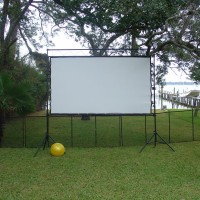
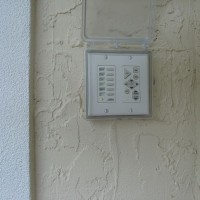
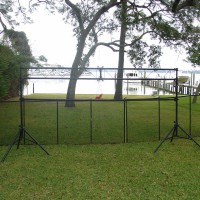

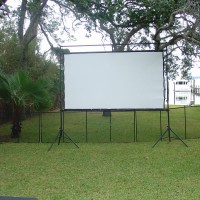
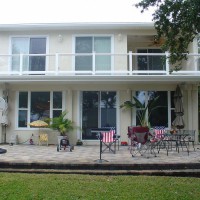
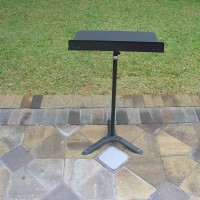
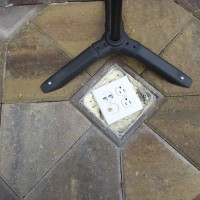



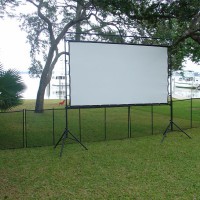
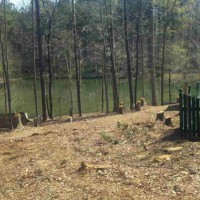
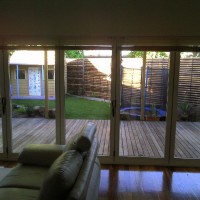
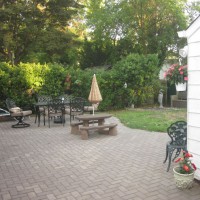
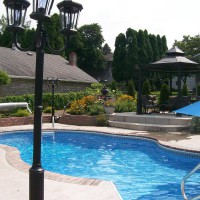
Comments / Questions
They are ball bungies. You can get them in various lengths. I used 6" for the top and bottom and 9" for the sides.
Love it. very cost effective :) by what did you use to old the screen to the tube? those are elastic bands or what? what do you call it and where to get it? thanks and great work bigdog
Bigdog that is so awesome.. Football heaven
How cool. Reminds me of the old Drive In theaters. nalso a nice way to get the neighbors together.
Add Comment or Question
Login to add comments.